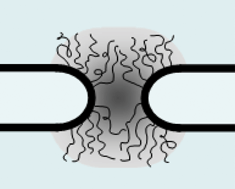Nuclear pores and membrane holes: generic models for confined chains and entropic barriers in pore stabilization†
Abstract
The lumen of the

- This article is part of the themed collection: Cells and proteins at interfaces
a
Laboratory for Research on the Structure of Matter, University of Pennsylvania, Philadelphia, Pennsylvania 19104
E-mail:
discher@seas.upenn.edu
Fax: +1 (215) 573-2093
Tel: +1 (215) 898-4809
The lumen of the

 Please wait while we load your content...
Something went wrong. Try again?
Please wait while we load your content...
Something went wrong. Try again?
P. J. Photos, H. Bermudez, H. Aranda-Espinoza, J. Shillcock and D. E. Discher, Soft Matter, 2007, 3, 364 DOI: 10.1039/B611412C
To request permission to reproduce material from this article, please go to the Copyright Clearance Center request page.
If you are an author contributing to an RSC publication, you do not need to request permission provided correct acknowledgement is given.
If you are the author of this article, you do not need to request permission to reproduce figures and diagrams provided correct acknowledgement is given. If you want to reproduce the whole article in a third-party publication (excluding your thesis/dissertation for which permission is not required) please go to the Copyright Clearance Center request page.
Read more about how to correctly acknowledge RSC content.
 Fetching data from CrossRef.
Fetching data from CrossRef.
This may take some time to load.
Loading related content
